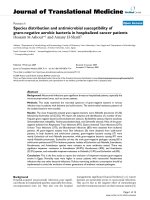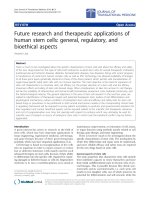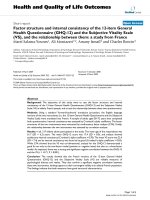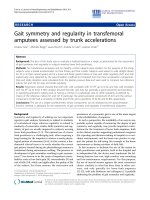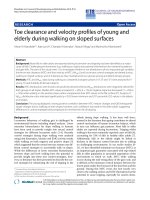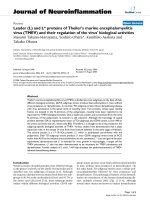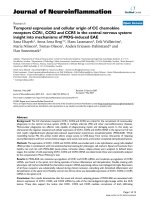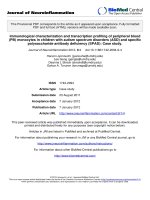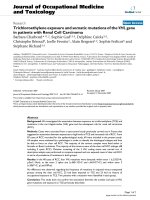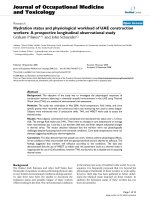Báo cáo hóa học: " Preparation, characterization and photocatalytic behavior of WO3-fullerene/TiO2 catalysts under visible light" pot
Bạn đang xem bản rút gọn của tài liệu. Xem và tải ngay bản đầy đủ của tài liệu tại đây (3.04 MB, 11 trang )
NANO EXPRESS Open Access
Preparation, characterization and photocatalytic
behavior of WO
3
-fullerene/TiO
2
catalysts under
visible light
Ze-Da Meng, Lei Zhu, Jong-Geun Choi, Chong-Yeon Park and Won-Chun Oh
*
Abstract
WO
3
-treated fullerene/TiO
2
composites (WO
3
-fullerene/TiO
2
) were prepared using a sol-gel method. The composite
obtained was characterized by BET surface area measurements, X-ray diffraction, scanning elect ron microscopy,
energy dispersive X-ray analysis, transmission electron microscopy, and UV-vis analysis. A methyl orange (MO)
solution under visible light irradiat ion was used to determine the photocatalytic activity. Excellent photocatalytic
degradation of a MO solution was observed using the WO
3
-fullerene, fullerene-TiO
2
, and WO
3
-fullerene/TiO
2
composites under visible light. An increase in photocatalytic activity was observed, and WO
3
-fullerene/TiO
2
has the
best photocatalytic activity; it may attribute to the increase of the photo-absorption effect by the fullerene and the
cooperative effect of the WO
3
.
Introduction
Textile manufacturing inv olves several processes which
generate large quantities of wastewaters. These effluents
are highly variable in composition with relatively low
biochemical oxygen demand and high chemical oxygen
demand contents and are typically characterized as fol-
low: first: strong color due to residual dyes, second:
recalcitrance due to the presence of compounds such as
dyes, surfactants, and sizing agents; and third: high
salinity, high temperature, and variable pH [1-3]. The
textile effluents effective treatment usually requires a
combination of various physical, chemical, and biological
technologies. Some studies researched the treatment of
model solutions containing various commercial dyes
with emphasis on azo dyes since these are extensively
used in dyeing processes. These azo dye molecules are
chemically stable and hardly biodegradable aerobically.
Most attention has been paid on the oxidative degrada-
tion of MB and MO representative mono-azo dyes by
oxidation processes [4,5]. TiO
2
is the most widely used
photocatalyst far effective decomposition of organic
compounds in air and water under irradiation of UV
light with wavelength shorter than corresponding to its
band gap energy, due to its relatively high photocatalytic
activity, biological and chemical stability, low cost, non-
toxic nature, and long-term stability. However, the
photocatalytic activity of TiO
2
(the band gap of anatase
TiO
2
is 3.2 eV and it can be excited by photons with
wavelengths below 387 nm) is limited to irradiation
wavelengths in the UV region [6,7]. However, only
about 3% to 5% of the solar spectrum falls in this UV
range. This limits the efficient utilization of solar energy
for TiO
2
. Some problems still remain to be solved in its
application, such as the fast recombinatio n of photogen-
erated electron-hole pairs. Therefore, improving p hoto-
catalytic activity by modification has be come a hot topic
among researchers in recent years [8,9].
For the improvement of the photocatalytic activity of
TiO
2
,TiO
2
has been coupled with other semiconductors
such as SnO
2
[10] which can induce effective charge
separation by trapping photogenerated electrons. TiO
2
coupled with other semiconductors has been repor ted to
perform both the abovementioned functions. This has
been realized by coupling the WO
3
[11] semiconductor
with TiO
2
. Because of its band gap (E
g
=2.6eVto
approximately 3.0 eV) [12], WO
3
mainly absorbs in the
near ultraviolet and blue regions of the solar spectrum.
As a basic function, WO
3
has a suitable conduction band
potential to allow the transfer of photogenerated elec-
trons from TiO
2
facilitating effective charge separation.
* Correspondence:
Department of Advanced Materials Science & Engineering, Hanseo
University, Seosan, Chungnam, 356-706, South Korea
Meng et al. Nanoscale Research Letters 2011, 6:459
/>© 2011 Meng et al; licensee Springer. This is an Open Access article distributed under the terms of the Crea tive Commons Attribution
License ( which perm its unrestricted use, distribution, and reproduction in any medium,
provided the origin al work is properly cited.
However, in practical applications, the photoelectrical
properties and photocatalytic efficiency of WO
3
require
improvement.
C
60
has attracted considerable interest for its interest-
ing properties o wing to the delocalized conjugated
structures and electron-accepting ability. One of the
most remarkable properties of C
60
in electron-transfer
processes is t hat it can efficiently arouse rapid photoin-
duced charge separation and relatively slow charge
recombination [13]. Therefore, a combination of photo-
catalysts and C
60
might provide an ideal system to
achieve enhanced charge separation by photoinduced
electron transfer. Some fullerene-donor linked molecules
on an electrode were reported to exhibit excell ent
photovoltaic effects upon photo-irradiation.
A conjugated two-dimensional π-system is suitable not
only for synthetic light-harvesting systems but also for
efficient electron transfer because the uptake or release
of electrons results in minimal structural and solvation
change upon electron transfer. Fullerenes contain an
extensively conjugated three-dimensional π-system and
are described as having a closed-shell configuration con-
sisting of 30 bonding molecular orbitals with 60 π-elec-
trons. This material i s also suitab le for efficien t
electron-transfer reduction b ecause of the minimal
changes in structure and salvation associated with elec-
tron transfer [14,15].
Unfortunately, deposited metal particles or coupled
with other semiconductors only serve as electron trap-
ping agent, or transfer of photogenerated electrons and
are not eff ective to enhance the adsorption of the pollu-
tants. Fullerene-treated TiO
2
coupled with other semi-
conductors has been reported to perform both the
abovementioned functions [16]. In addition, C
60
is one
of the promising materials because of its band gap
energy, about 1.6 to 1.9 eV. It has strong absorption in
the ultraviolet region and weak but significant bands in
the visible region. In general, the coupled systems exhi-
bit higher degradation rate as wel l as the increased
extent of degradation [17]. The studies for comparing
the coupled semiconductors with visible light, however,
are scarce.
In this paper, WO
3
-treated fullerene, fullerene-sup-
ported TiO
2
,andWO
3
-fullerene/TiO
2
were synt hesized
and exhibited enhanced vis-photocatalytic activities
compared to the pure TiO
2
. This study focused on the
fabrication and characterization of WO
3
-fullerene/TiO
2
composite in a prepa ration procedure. Structure varia-
tions, surface state, and elemental compositions were
examined for the preparation of WO
3
-fullerene/TiO
2
composites. X-ray diffraction (XRD), scanning electron
microscopy (SEM), energy disp ersive X-ray (EDX),
transmission electron microscopy (TEM), and UV-visi-
ble (UV-vis) were used to characterize these new photo-
catalysts. The catalytic efficiency of the WO
3
-fullerene/
TiO
2
composite was evaluated by the photo degradation
of methyl orange (MO, C
14
H
14
N
3
NaO
3
S).
Materials
Benzene (99.5%) and ethyl a lcohol were purchased as
reagent-grade from Duksan Pure Chemical Co.
(Ansan-si, Gyeonggi-do, South Korea) an d Daejung
Chemical Co. (Gwangju-si, Gyeonggi-do, South Korea)
and were used as received. Crystalline fullerene [C
60
]
powder (99.9% purity from Tokyo Kasei Kogyo Co.
Ltd., Tokyo, Japan) was used as the carbon matrix.
Titanium(IV) n-butoxid e (TNB, C
16
H
36
O
4
Ti) as the
titanium source for the preparation of the WO
3
-fuller-
ene/TiO
2
composites was purchased as reagent-grade
from Acros Organics (Morris Plains, NJ, USA). The
ammonium metatungstate hydrate (H
26
N
6
O
40
W
12
·-
xH
2
O) purchased from Sigma-Aldrich™ Chemie
GmbH (Steinheim, Germany) was used as a raw mate-
rial to generate WO
3
at high temperatures. Methyl
orange (MO, C
14
H
14
N
3
NaO
3
S, 99.9%, Duksan Pure
Chemical Co., Ltd) was of analytical grade.
Preparation of WO
3
-fullerene composites
MCPBA (m-chloroperbenzoic acid, ca. 1 g) was sus-
pended in 50 ml benzene, followed by the addition o f
fullerene (ca. 30 mg). The mixture was heated under
reflux in air and stirred for 6 h at 343 K. The solvent
was then dried at the boiling point of benzene (353.13
K). After completion, the dark brown precipitates were
washed with ethyl alcohol and dried at 323 K, resulting
in the formation of oxidized fullerene. For WO
3
coating,
3.8 × 10
-5
mol H
26
N
6
O
40
W
12
·xH
2
O was added to 50 ml
of distilled water (shown in Table 1). The resulting mix-
turewasheatedunderrefluxinairandstirredat343K
for 6 h using a magnetic stirrer in a vial. After heat
treatment at 773 K for 1 h, the WO
3
-fullerene com-
pounds were formed.
Table 1 Nomenclature of the samples prepared with the photocatalysts
Preparation method Nomenclatures
3.8 × 10
-5
mol H
26
N
6
O
40
W
12
·xH
2
O+H
2
O + MCPBA + 30 mg fullerene WO
3
-fullerene
MCPBA+ benzene + 30 mg fullerene + 3 ml TNB Fullerene-TiO
2
MCPBA+ benzene + 30 mg fullerene + 3.8 × 10
-5
mol H
26
N
6
O
40
W
12
·xH
2
O+H
2
O + benzene + 3 ml TNB WO
3
-fullerene/TiO
2
Meng et al. Nanoscale Research Letters 2011, 6:459
/>Page 2 of 11
Preparation of WO
3
-fullerene/TiO
2
composites
WO
3
-fullerene was prepared using pristine concentra-
tions of TNB for the preparation of WO
3
-fullerene/TiO
2
composites. WO
3
-fullerene powder was mixed with 3 ml
TNB. The solutions were homogenized under reflux at
343 K for 5 h, while being stirred in a vial. After stirring,
the solution transformed to WO
3
-fullerene/TiO
2
gels
and heat treated at 873 K to produce the WO
3
-fuller-
ene/TiO
2
composites.
Characterization of photocatalysts compounds
To measure the structural variations, XRD patterns were
obtained using an X-ray generator (Shimadzu XD-D1,
Shimadzu Corporation, Kyoto, Japan) with Cu Ka radia-
tion. Scanning electron microscopy (SEM, JSM-5200,
JEOL, Tokyo, Japan) was used to observe the surface
state and structure of the photocatalyst composites.
Energy dispersive X-ray spectroscopy (EDX) was also
used for elemental analysis of the samples. The specific
surfacearea(BET)wasdeterminedbyN
2
adsorption
measurements at 77 K ( Monosorb, Quantachrome
Instruments Ltd, Boynton Beach, FL, USA). Transmis-
sion electron microscopy (TEM, JEM-2010, JEOL) was
used to observe the surface state and structure of the
photocatalyst composites at an acceleration voltage of
200 kV. TEM was also used to examine the size and dis-
tribution of the titanium and iron particles deposited on
the fullerene surface of various samples. The TEM spe-
cimens were prepared by placing a few drops of the
sample solution on a carbon grid. UV-vis diffused reflec-
tance spectra were obtained using a UV-vis spectrophot-
ometer (Neosys-2000, Scinco, Seoul, South Korea) by
using BaSO
4
as a reference and were converted from
reflection to absorbance by the Kubelka-Munk method.
Photocatalytic degradation of MO
The photocatalytic activities were evaluated by MO
degradation in aqueous media under visible light irradia-
tion. For visible light irradiation, the reaction beaker was
located axially and held in a visible lamp (8 W, ha loge n
lamp, KLD-08L/P/N, Fawoo Technology, Bucheon Si,
South Korea) box. The luminous efficacy of the lamp is
80 lm/W, and the wavelength is 400 nm to approxi-
mately 790 nm. The lamp was used at a distance of 100
mm from the aqueous solution in a dark box. The initial
concentration of the MO was set at 1 × 10
-5
mol/L in
all experiments. The amount of the photocatalysts
(WO
3
-fullerene, fullerene-TiO
2
,andWO
3
-fullerene/
TiO
2
) composite was 0.05 g per 50 ml solution. The
reactor was placed for 2 h in the darkness box in order
to make the photocatalyst composites particles adsorbed
the MO molecule maximum. After the adsorptio n state,
the visible light irradiation was restarted to make the
degradation reaction proceed. In the process of
degradation of methyl orange, a glass reactor (diameter
= 4 cm, height = 6 cm) was used and the reactor was
placed on the magnetic churn dasher. The suspension
was then irradiated with visible light for a set irradiation
time. Visible light irradiation of the reactor was done
for 10, 30, 60, 90, and 120 min, respectively. Samples
were withdrawn regularly from the reactor and dis-
persed powders were removed by a centrifuge. The
clean transparent solution was analyzed by UV/vis spec-
troscopy. The MO concentration in the solution was
determined as a function of the irradiation time.
Elemental analysis of the preparation
Figure 1 shows the EDX patterns of the WO
3
-treated
fullerene, fullerene-supported TiO
2
, and WO
3
-fulle rene/
TiO
2
. EDX indicated C, O, Ti, and W as the major ele-
ments in the composites. T able 2 lists the numerical
results of EDX quantitative microanalysis of the samples.
Figure 1c shows the presence of C, O, and Ti, as major
elements with strong W peaks. There were some small
impur ities, which were attributed to the use of fullerene
without purification. In most samples, carbon and tita-
nium were present as major elements with small quanti-
ties of oxygen in the composite.
Surface characteristics of the samples
Table 2 lists the specific surface area (BET) of the mate-
rials examined. The BET surface area of pure TiO
2
was
18.95 m
2
/g, and the surface area of pure fullerene was
85.05 m
2
/g. Tungsten oxide particles were introduced
into the pores of fullerene, which decreased the BET
surface area. The surface area of fullerene-TiO
2
was
64.62 m
2
/g. Fullerene contains many pores, which can
increase the surface area of the photocatalyst. The BET
surface area decreased from 85.05 m
2
/g for pure fuller-
ene to 57.74 m
2
/g for WO
3
-fullerene/TiO
2
. This sug-
gests that the TiO
2
and tungsten oxide were introduced
into the pores of the fullerene s, which decreased the
BET surface area. The WO
3
-fullerene sample had the
largest surface area, which can affect the adsorption
reaction.
The micro-surface structures and morphology of the
fulleren e-TiO
2
,WO
3
-fullerene, and WO
3
-fullerene/TiO
2
composites were characterized by SEM (Figure 2). SEM
is used for inspecting topographies of specimens at very
high magnifications using a piece of equipment called
the scanning electron microscope. Figure 2 shows the
macroscopic changes in the morphology of the WO
3
-
fullerene, fullerene-TiO
2
,andWO
3
-fullerene/TiO
2
.In
Figure 2a, WO
3
-fullerene has the small particle size and
a good dispersion. The fullerene particles were spherical
particles in shape with small facets, and fullerene has a
good dispersion [18]. For the fullerene-TiO
2
sample
(Figure 2b), the fullerene particles were well attached to
Meng et al. Nanoscale Research Letters 2011, 6:459
/>Page 3 of 11
the TiO
2
surface with a uniform distribution, but the
particle size is bigger than WO
3
-fullerene. Zhang et al.
reported that a good dispersion of small particles could
provide more reactive sites for the reactants than aggre-
gated particles [19]. At the same time, the conductivity
of fullerene can facilitate electron transfer between the
adsorbed dye molecules and catalyst substrate. With the
WO
3
-fullerene/TiO
2
samples (Figure 2c), tungsten parti-
cles were fixed to the TiO
2
surface and fullerene parti-
cles in some spherical particl es, but the distribution was
(a)
(b)
(
c
)
Figure 1 EDX elemental microanalysis of WO
3
-fullerene, fullerene-TiO
2
, and WO
3
-fullerene/TiO
2
.
Table 2 EDX elemental microanalysis, BET surface area, and k
app
values of photocatalysts
Sample name C (%) O (%) W (%) Impurity (%) Ti (%) BET (m
2
/g) k
app
C
60
99.99 - - 0.01 - 85.05 -
TiO
2
- - - 0.01 99.99 18.95 2.24 × 10
-4
WO
3
-fullerene 54.08 17.25 22.92 5.75 - 73.25 2.86 × 10
-3
Fullerene-TiO
2
27.24 36.71 - 0.02 58.82 64.62 1.52 × 10
-3
WO
3
-fullerene/TiO
2
10.41 35.28 3.22 1.03 50.06 57.74 4.75 × 10
-3
Meng et al. Nanoscale Research Letters 2011, 6:459
/>Page 4 of 11
not uniform. There was no clear difference in the inten-
sity of aggregation. Because of the aggregation, fullerene
cannot show clearly. The particles were strongly aggre-
gated and that discrete particles were impossible to find
so the average particle size was difficult to obtain. It
may be that particles with similar or close crystallo-
graphic orientations were formed bulky crystal or quasi-
crystals with modulated surfaces and regular shapes.
Figure 3 shows TEM images of th e WO
3
-fullerene/
TiO
2
composites. T EM is a technique used for analyzing
the morphology, crystallographic structure, and even
compositing of a specimen. As shown in Figure 3, parti-
cles were observed upon enlargement of the images. This
indicates that the surface of the WO
3
particles is cleaned
under exposure to the reaction conditions. Figure 3
shows large clusters with an irregular agglomerated
(a)
(b)
(c)
Figure 2 SEM images of WO
3
-fullerene (a), fullerene-TiO
2
(b), and WO
3
-fullerene/TiO
2
(c).
Meng et al. Nanoscale Research Letters 2011, 6:459
/>Page 5 of 11
dispersion of TiO
2
. Fullerene were distributed uniformly
outsidethesurfaceoftheTiO
2
nanoparticles with a size
of approximately 10 to 20 nm, and WO
3
were distributed
uniformly over the surface of the fullerene and TiO
2
,
even though this caused partial agglomeration to form
block particles. TEM also revealed the presence of metal
nanoparticles on the fullerene particles.
Structural analysis
XRD was used t o determine the crystallographic struc-
ture of the inorganic component of the composite. Fig-
ure 4 shows the XRD patterns of the WO
3
-treated
fullerene, fullerene-supported TiO
2
, and WO
3
-fulle rene/
TiO
2
. In Figure 4, A is anatase and W is the monoclinic
phase of tungsten oxide. The structure of WO
3
-fullerene
composites showed monoclinic phase of t ungsten oxide.
The peaks at 23.15°, 23.61°, 24.37°, 26.61°, 33.33°, 33.65°,
34.01°, 41.51°, 44.88°, 47.22°, 49.32°, 50.48°, 53.46°, and
55.11° 2θ were assigned to diffraction planes of (001),
(020), (200), (120), (111), (021), (201), (220), (221), (131),
(002), (400), (112), (022), and (401) of monoclinic WO
3
phase [20,21]. WO
3
-fullerene/TiO
2
and fullerene-TiO
2
showed anatase phase of TiO
2
. The crystal structure of
TiO
2
is determined mainly by the heat-treated tempera-
ture. The peaks at 25.3°, 37.5°, 48.0°, 53.8°, 54.9°, and
62.5° 2θ were assigned to the (101), (004), (200), (105),
(211), and (204) planes of anatase [22-24], indicating the
developed fullerene/TiO
2
composites existed as anatase.
In the XRD patterns for WO
3
-fullerene/TiO
2
,thepeaks
at 23.15°, 23.61°, 24.37°, 26.61°, 33.33°, 33.65°, 34.01°,
and 41.51° 2θ were assigned to diffraction planes of
(001), (020), (200), (120), (021), (201), (220), and (221)
of monoclinic WO
3
phase. Due to the small content of
tungsten oxide (shown in Table 2), the intension of t he
peaks are smaller than that of WO
3
-fullerene, and the
other peaks cannot be found in these patterns.
UV-vis diffuse reflectance spectroscopy
The UV-vis absorption spectra of the samples are shown
in Figure 5; the illustration is UV-vis absorption spectra
of pure TiO
2
. We can find that TiO
2
,WO
3
-fullerene,
fullerene-TiO
2
,andWO
3
-fullerene/TiO
2
composites
have great absorption at ultraviolet region, but the
absorption edge of TiO
2
is approximately 400 nm ( E
g
=
3.2 eV). When at the visible region, WO
3
-fullerene, full-
erene/TiO
2
,andWO
3
-fullerene-TiO
2
composites have
good absorption; this is also means that these compo-
sites have great photocatalytic activity under visible light
irradiation. Because WO
3
has a relatively small band
gap (2.6 eV to approximately 3.0 eV), WO
3
have
Figure 3 TEM image of the WO
3
-fullerene/TiO
2
composites.
Meng et al. Nanoscale Research Letters 2011, 6:459
/>Page 6 of 11
10 20 30 40 50 60 70 8
0
0
200
400
600
800
1000
(c)
(b)
A
A
A
A
AA
A
A
A
W
WW
W
W
W
W
W
W
W
Relative intensity
2 theta ( )
W
(a)
(a)
WO
3
-fullerene
(b)
fullerene-TiO
2
(c)
WO
3
-fullerene/TiO
2
Figure 4 XRD patterns of WO
3
-fullerene (a), fullerene-TiO
2
(b), and WO
3
-fullerene/TiO
2
(c).
Figure 5 UV-vis absorption spectra of photocatalysts.
Meng et al. Nanoscale Research Letters 2011, 6:459
/>Page 7 of 11
photocatalytic activity at visible region, from the wave-
length at 400 to 443 nm. And fullerene also acted as a
photosensitizer, so that WO
3
-fullerene has good adsorp-
tion at visible region. In the case of fullerene-coupled
TiO
2
, fullerene acted as a p hotosensitizer, which could
be excited to inject e lectrons into the conduction band
of TiO
2
. Because of the synergistic reaction of WO
3
,
fullerene, and TiO
2
, the adsorption effect of WO
3
-fuller-
ene/TiO
2
is good at visible region [25,26].
Photocatalytic activity of samples
Two steps are involved in the photocatalytic decomposi-
tion of dyes, the adsorption of dye molecules, and their
degradation. After adsorption in the dark for 2 h, all the
samples reached adsorption-desorption equilibrium [27].
Figure 6 shows the adsorptive and degradation effect of
photocatalysts for MO. In the adsorptive step, TiO
2
,
WO
3
-fullerene, fullerene-TiO
2
, and WO
3
-fullerene/TiO
2
composites showed different adsorptive effects with
WO
3
-fullerene having the best adsorptive effect, and the
adsorptive effect of pure TiO
2
was the lowest. This is
because fullerene can enhance the adsorption effect.
WO
3
-fullerene has the largest BET surface area, which
will affect the adsorptive effect. The decolorization effi-
ciencies of WO
3
-fullerene, fullerene-TiO
2
,andWO
3
-
fullerene/TiO
2
composites were 45.17%, 32.12%, and
23.41%, respectively. These results are consistent with
the BET surface areas.
In the degradation step, Figure 6 shows the results of
TiO
2
,WO
3
-fullerene, fullerene-TiO
2
,andWO
3
-fuller-
ene/TiO
2
composites degradation MO solutions under
visible light. The relative yields of the photolysis pro-
ducts formed under different irradiation time conditions
are shown for the products. The dye concentration was
1.0 × 10
-5
mol/l, and the absorbance decreased with
increasing irradiation time. This suggests that the light
transparency of the dye concentration was increased
greatly by the photocatalytic degradation effect. The
effect of the high crystallinity of the anatase phase on
the photocatalyt ic degradation of dye was shown. Under
visible light irradiation, TiO
2
cannot depredate MO
molecules, but WO
3
-fullerene, fullerene-TiO
2
,and
WO
3
-fulle rene/Ti O
2
composites have good photocataly-
tic activity. Comparing these three samples, WO
3
-fuller-
ene/TiO
2
composite has the best degradation effect,
which is due to the synergistic reaction of WO
3
,fuller-
ene, and TiO
2
.
Figure 7 presents the corresponding -ln(C/C
0
)vs.t
plots at 0 to 120 min irradiation time. The photodegra-
dation followed first-order kinetics. The kinetics can be
expressed as follows: -ln(C/C
0
)=k
app
t, where k
app
is the
apparent reaction rate constant, and C
0
and C are the
initial concentration and the reaction concentration of
MO, respectively. Table 2 shows the rate constant values
(k
app
)ofpureTiO
2
,WO
3
-fullerene, fullerene-TiO
2
,and
WO
3
-fullerene/TiO
2
composites for the degradation of
-120 -110 0 50 100
0.4
0.6
0.8
1.0
1.2
TiO
2
WO
3
-fullerene
fullerene-TiO
2
WO
3
-fullerene/TiO
2
Absorbance
Irradiation time
(
min
)
Adsorption
Photo-degradation
Figure 6 Decolorization effect on MO of pure TiO
2
,WO
3
-fullerene, fullerene-TiO
2
, and WO
3
-fullerene/TiO
2
.
Meng et al. Nanoscale Research Letters 2011, 6:459
/>Page 8 of 11
the MO solution. The k
app
value of the WO
3
-fullerene/
TiO
2
sample is the largest, which is in accord with the
photocatalytic activity.
Fullerene-TiO
2
has a better degradation effect than
pure TiO
2
because fullerene is an energy sensitizer that
improves the quantum efficiency and increases charge
transfer [28,29]. The TiO
2
deposited on the fullerene
surface can retain its photodegradation activity. In the
fullerene-co upled TiO
2
sys tem, the photocatalytic activ-
ities were enhanced mainly due to the high effici ency of
charge separation induced by the synergistic effect of
fullerene and TiO
2
. In the case of fullerene-coupled
TiO
2
, hole and electron pairs were generated and sepa-
rated on the interface of fullerene by visible light irradia-
tion. The level of the conduction band in TiO
2
was
lower than the reduction potential of fullerene. There-
fore, the photogenerated electron can transfer easily
from the conduction band of fullerene to a TiO
2
mole-
cule with an interaction between fullerene and TiO
2
.
Simultaneously, the holes in the valence band (VB) of
TiO
2
can transfer directly to fullerene because the VB of
TiO
2
matches well with fullerene. The synergistic effect
fullerene and TiO
2
both promoted the separation effi-
ciency of the photogenerated electron-hole pairs, result-
ing in the high photocatalytic activity of fullerene-
hybridized TiO
2
samples. In this case, the fullerene-
coupled TiO
2
system improved the reaction state
[30-32]. Therefore, the fullerene-coupled TiO
2
has
photocatalytic activity under visible light. Figure 8 shows
a schematic diagram of the separation of photogenerated
electrons and holes on the fullerene-TiO
2
interface.
WO
3
-fullerene also has a barrier degradation effect
than pure TiO
2
, due to the same reason as fullerene-
TiO
2
system. From Figure 6 and Table 2, we can find
that the k
app
of WO
3
-fullerene is 2.86 × 10
-3
,whichis
larger than that of fullerene-TiO
2
(1.52 × 10
-3
). This is
because, with the band gap of WO
3
being relatively
small, electrons will obtain energy to jump onto the
conduction band and become free electrons named
photoelectrons when under visible light irradiation. In
this system hole and electron pairs were also generated
and separated on the interface of fullerene. Fullerene is
acted as photosensitize. These electron-hole pairs can
recombine or diffuse to the surface where they can initi-
ate redox reactions with surface species, so the degrada-
tion effects of TiO
2
-fullerene and WO
3
-fullerene/TiO
2
were limited.
At WO
3
-fullerene/TiO
2
system, the photocatalytic
activities were enhanced mainly due to the high effi-
ciency of charge separation induced by the synergistic
effect of fullerene, WO
3
,andTiO
2
. Because of the least
band gap of fullerene (1.6 to 1.9 eV), hole and electron
pairs were generated and separated on the interface of
fullerene easily by visible light ir radiation, and the
0 20 40 60 80 100 120
0.0
0.1
0.2
0.3
0.4
0.5
0.6
TiO
2
WO
3
-fullerene
TiO
2
-fullerene
WO3-fullerene/TiO
2
-ln (c/c
o
)
Irradiation time
(
min
)
Figure 7 Corresponding -ln(C/C
0
) vs. t plots.
Meng et al. Nanoscale Research Letters 2011, 6:459
/>Page 9 of 11
electron can transfer easily from the CB of fullerene to a
TiO
2
molecule and, simultaneously, the holes in the VB
of TiO
2
can transfer directly to fullerene because both
the conductio n band (CB) and the valence band (VB) of
WO
3
were higher than the CB and VB of TiO
2
and full-
erene. When the hole and electron pairs were also gen-
erated and separated on the interface of WO
3
, electrons
at the CB of WO
3
migrated to CB of TiO
2
and fuller-
ene, and holes at the VB of WO
3
migrated to VB of
TiO
2
and fullerene [33]. This can allow the transfer of
photogenerated electrons facilitating effective charge
separation and decreased the rate of recombination
about the electron-hole pairs. Fullerene also acts as the
adsorb facient and increases the surface area of com-
pounds which can increase the adsorption effect for
samples, adsorbed more O
2
and dye molecules, and
make sure this systems take full advantage of yield oxi-
dizing species. Figure 8 is the s chematic diagram of the
separation of photogenerated electrons and holes on the
WO
3
-fullerene/TiO
2
interface. Electrons and holes were
used to produce the hydroxyl radicals (OH
·
)andsuper-
oxide ions (O
2
·-
). Oxidative degradation of azo dyes
occurs by the attack of hydroxyl radicals and superoxide
ions, which are the highly reactive electrophilic oxidants.
Due to the efficiency of hydroxyl radicals and superox-
ide ions, azo dyes were decompounded to CO
2
,H
2
O,
and inorganic.
Conclusions
This study examined the preparation and characteriza-
tion of WO
3
-fullerene, fullerene-TiO
2
,andWO
3
-fuller-
ene/TiO
2
. The BET surface area of pristine fullerene
was higher than that of the WO
3
-fullerene/TiO
2
compo-
site. XRD revealed the WO
3
structure and anatase. TEM
showed that TiO
2
particles with some agglomerates
were dispersed over the surface of fullerene together
with WO
3
particles. In UV-vis absorption, spectra sam-
ples have shown a great adsorption at visible region.
Fullerene-TiO
2
has a good photodegradation effect
under visible light irradiation, due to the photosensitiv-
ity, and enhances the BET surface area effect of fuller-
ene. The WO
3
-fullerene/TiO
2
composite showed the
best photoca talytic degradation activity of the MO solu-
tion under visible light irradiation. This was attributed
to the three different effects between the photocatalytic
reactions of the supported TiO
2
, to the en ergy transfer
Figure 8 Schematic diagram of the separation of photogenerated electrons and holes on the WO
3
-fullerene/TiO
2
interface.
Meng et al. Nanoscale Research Letters 2011, 6:459
/>Page 10 of 11
effects of fullerene and WO
3
, such as electrons and
light, and to the separation effect in this system.
Authors’ contributions
The work presented here was carried out in collaboration between all
authors. WCO an MZD defined the research theme. MZD and WCO
designed methods and experiments, and experiments and wrote the paper.
LZ carried out the laboratory experiments. JGC and CYP analyzed the date,
interpreted the results. All authors have contributed to, seen and approved
the manuscript.
Competing interests
The authors declare that they have no competing interests.
Received: 6 April 2011 Accepted: 20 July 2011 Published: 20 July 2011
References
1. Dvoranova D, Brezova V, Mazur M, Malati MA: Investigations of metal-
doped titanium dioxide photocatalysts. Appl Catal B-Environ 2002, 37:91.
2. Tseng IH, Chang WC, Wu JCS: Photoreduction of CO
2
using sol-gel
derived titania and titania-supported copper catalysts. Appl Catal B:
Environ 2002, 37:37.
3. Yamashita H, Fujii Y, Ichihashi Y, Zhang SG, Ikeue K, Park DR, Koyano K,
Tatsumi T: Selective formation of CH
3
OH in the photocatalytic reduction
of CO
2
with H
2
O on titanium oxides highly dispersed within zeolites and
mesoporous molecular sieves. M Anpo Catal Today 1998, 45:221.
4. Meng ZD, Oh WC: Photocatalytic degradation of methylene blue on Fe-
fullerene/TiO
2
under visible-light irradiation. Asian J Chem 2011, 23:847.
5. Zhu L, Meng ZD, Chen ML, Zhang FJ, Choi JG, Park JY, Oh WC:
Photodegradation of MB solution by the metal (Fe, Ni and Co)
containing AC/TiO
2
photocatalyst under the UV irradiation. J Photo Sci
2010, 1:69.
6. Meng ZD, Zhang K, Oh WC: Preparation of different Fe containing TiO
2
photocatalysts and comparison of their photocatalytic activity. Korean J
Mater Res 2010, 20:228.
7. Asahi R, Morikawa T, Ohwaki T, Aoki K, Taga Y: Visible-light photocatalysis
in nitrogen-doped titanium oxides. Science 2001, 293:269.
8. Khan SUM, Al-Shahry M, Ingler WB: Efficient photochemical water splitting
by a chemically modified n-TiO
2
. Science 2002, 297:2243.
9. Meng ZD, Zhu L, Choi JG, Zhang FJ, Oh WC: Effect of Pt treated fullerene/
TiO
2
on the photocatalytic degradation of MO under visible light. J
Mater Chem 2011, 21:7596.
10. Akurati KK, Vital A, Hany R, Bommer B, Graule T, Winterer M: One-step
flame synthesis of SnO
2
/TiO
2
composite nanoparticles for photocatalytic
applications. Int J Photoenergy 2005, 7:153.
11. Sajjad AKL, Shamaila S, Tian B, Chen F, Zhang J: One step activation of
WO
x
-TiO
2
nanocomposite with enhanced photocatalytic activity. Appl
Catal B: Environ 2009, 91:397.
12. Xiao MW, Wang LS, Huang XJ, Wu YD, Dang Z: Synthesis and
characterization of WO
3
/titanate nanotubes nanocomposite with
enhanced photocatalytic properties. J Alloys Compd 2009, 470:486.
13. Davis JJ, Hill HAO, Kurz A, Leighton AD, Safronov AY: The aqueous
electrochemistry of C
60
and methanofullerene films. J Ele Chem 1997,
429:7.
14. Szucs A, Loix A, Nagy JB, Lamberts L: Fullerene film electrodes in aqueous
solutions. Part 1. Preparation and electrochemical characterization. J Ele
Chem 1995, 397:191.
15. Nakashima N, Ishii T, Shirakusa M, Nakanishi T, Murakami H, Sagara T:
Molecular bilayer-based superstructures of a fullerene-carrying
ammonium amphiphile: structure and electrochemistry. Chem Eur J 2001,
7:1766.
16. Haddon RC, Hebard AF, Rosseinsky MJ, Murphy DW: Conducting films of
C
60
and C
70
by alkali-metal doping. Nature 1991, 350:320.
17. Meng ZD, Oh WC: Sonocatalytic degradation and catalytic activities for
MB solution of Fe treated fullerene/TiO
2
composite with different
ultrasonic intensity. Ultras Sonochem 2011, 18:757.
18. Zhu WZ, E Miser D, Chan WG, Hajaligol MR: Characterization of
combustion fullerene soot, C
60
, and mixed fullerene. Carbon 2004,
42:1463.
19. Zhang XW, Zhou MH, Lei LC: Preparation of photocatalytic TiO
2
coating
of nanosized particles supported on activated carbon by AP-MOCVD.
Carbon 2005, 43:1700.
20. Li XZ, Li FB, Yang CL, Ge WK: Photocatalytic activity of WO
x
-TiO
2
under
visible light irradiation. J Photochem Photobiol A: Chem 2001, 141:209.
21. Song H, Jiang H, Liu X, Meng G: Efficient degradation of organic pollutant
with WO
x
modified nano TiO
2
under visible irradiation. J Photochem
Photobiol A: Chem 2006, 181:421.
22. Lee J, Choi W: Photocatalytic reactivity of surface platinized TiO
2
:
substrate specificity and the effect of Pt oxidation state. J Phys Chem B
2005, 109:7399.
23. Yang J, Bai HZ, Jiang Q, Lian JS: Visible-light photocatalysis in nitrogen-
carbon-doped TiO
2
films obtained by heating TiO
2
gel-film in an ionized
N
2
gas. Thin Sol Films 2008, 516:1736.
24. Yang XX, Cao CD, Erickson L, Hohn K, Maghirang R, Klabunde K: Synthesis
of visible-light-active TiO
2
-based photocatalysis by carbon and nitrogen
doping. J Catalysis 2008, 260:128.
25. Liu BS, Zhao XJ, Zhao QN, He X, Feng JY: Effect of heat treatment on the
UV-vis-NIR and PL spectra of TiO
2
films. J Elec Spec Rela Pheno 2005,
148:158.
26. Liu ZL, Cui ZL, Zhang ZK: The structural defects and UV-VIS spectral
characterization of TiO
2
particles doped in the lattice with Cr
3+
cations.
Mater Character 2005, 54:123.
27. Meng ZD, Chen ML, Zhang FJ, Zhu L, Cho JG, Oh WC: Rare earth
oxide0doped fullerene and titania composites and photocatalytic
properties of methylene blue under visible light. Asian J Chem 2011,
23:2327.
28. Brabec CJ, Sariciftci NS, Hummelen JC: Plastic Solar Cells. Adv Funct Mater
2001, 11:15.
29. Sun YP, Gudure R, Lawson GE, Mullins JE, Guo Z, Quinlan J, Bunker CE,
Gord JR: Photophysical and electron-transfer properties of mono- and
multiple functionalized fullerene derivatives. J Phys Chem B 2000,
104:4625.
30. Yamamoto K, Saunders M, Khong A, Gross RJ, Grayson JM, Gross ML,
Benedetto AF, Weisman RB: Isolation and spectral properties of Kr@C
60
,a
Stable van der Waals Molecule. J Am Chem Soc 1999, 121:1591.
31. Pore V, Ritala M, Leskela M, Areva S, Jarn M, Jarnstrom J: H
2
S modified
atomic layer deposition process for photocatalytic TiO
2
thin films. J
Mater Chem 2007, 17:1361.
32. Zhang FJ, Oh WC: Photoelectrocatalytic properties of Mo-CNT/TiO
2
composite electrodes under visible light. Asian J Chem 2011, 23:372.
33. Wang Y, Cai L, Li YY, Tang Y, Xie CS: Structural and photoelectrocatalytic
characteristic of ZnO/ZnWO
4
/WO
3
nanocomposites with double
heterojunctions. Physica E 2010, 43:503.
doi:10.1186/1556-276X-6-459
Cite this article as: Meng et al.: Preparation, characterization and
photocatalytic behavior of WO
3
-fullerene/TiO
2
catalysts under visible
light. Nanoscale Research Letters 2011 6:459.
Submit your manuscript to a
journal and benefi t from:
7 Convenient online submission
7 Rigorous peer review
7 Immediate publication on acceptance
7 Open access: articles freely available online
7 High visibility within the fi eld
7 Retaining the copyright to your article
Submit your next manuscript at 7 springeropen.com
Meng et al. Nanoscale Research Letters 2011, 6:459
/>Page 11 of 11
